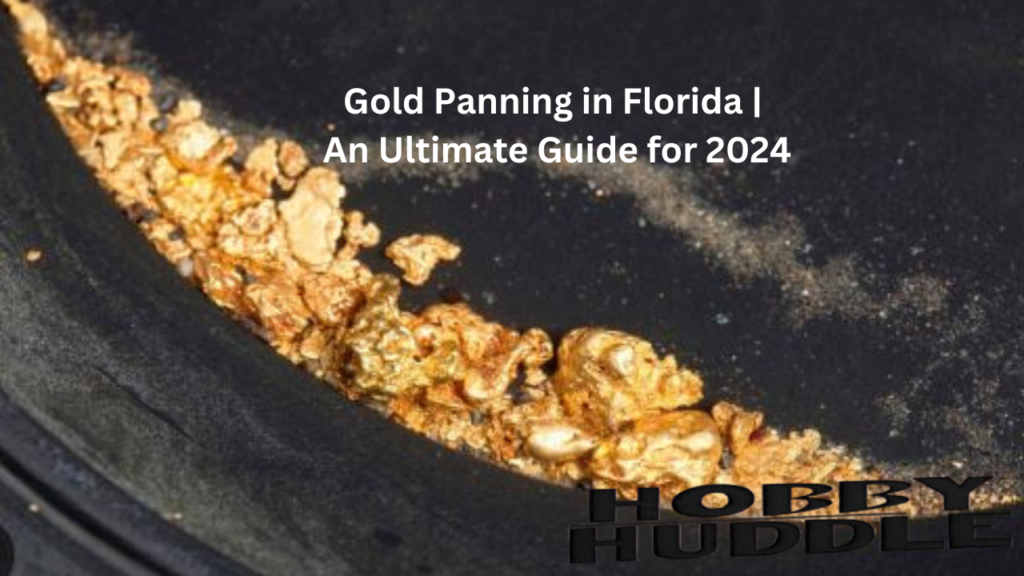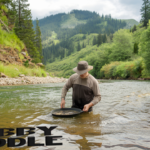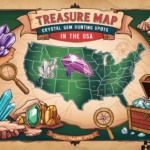Unearthing Florida’s Hidden Treasures
Florida, known for its sunny beaches and theme parks, holds a secret that many overlook: gold. While not as famous as California or Alaska, the Sunshine State offers unique opportunities for gold panning enthusiasts.
This comprehensive guide will take you through everything you need to know about gold panning in Florida in 2024, from techniques to locations and regulations.
The Allure of Florida Gold
Gold prospecting in Florida combines the thrill of treasure hunting with the beauty of outdoor adventure. Imagine standing knee-deep in a crystal-clear stream, the Florida sun warming your back as you sift through sediment, your heart racing with each glint of possibility. This is the reality for many who have discovered the joy of gold panning in Florida’s diverse landscapes.
You Might Like: Gold Panning in Virginia: Everything You Need to Know in 2024
Historical Context
Florida’s gold rush history may not be as well-known as other states, but it has its own fascinating story. In the late 19th century, small gold deposits were discovered in the northern part of the state, sparking interest among prospectors. While large-scale mining never took off, the legacy of these early discoveries lives on in the form of recreational gold panning.
Understanding Florida’s Geology
To successfully pan for gold in Florida, it’s crucial to understand the state’s unique geological formations. Florida’s gold deposits are primarily placer gold, formed by the erosion of gold-bearing rocks and the subsequent deposition of gold particles in streams and rivers.
| Geological Formation | Description | Potential for Gold |
|---|---|---|
| Appalachian Mountains Runoff | Sediment from ancient mountain range | High |
| Coastal Plain Deposits | Accumulated marine sediments | Moderate |
| River Basins | Alluvial deposits in major rivers | High |
| Limestone Bedrock | Sedimentary rock formations | Low |
| Sand Dunes | Wind-blown sand deposits | Very Low |
| Wetlands | Organic-rich sediments | Low |
| Karst Topography | Dissolved limestone landscapes | Moderate |
| Barrier Islands | Coastal sand accumulations | Low |
| Phosphate Deposits | Marine sedimentary formations | Moderate |
| Spring Formations | Groundwater discharge areas | Low |
Best Locations for Gold Panning
While gold can be found throughout Florida, some areas are more promising than others. The northern part of the state, particularly areas near the Georgia border, tends to yield better results. Here are some top locations to consider:
Suwannee River
The Suwannee River, immortalized in song, offers more than just scenic beauty. Its waters carry fine gold particles, making it a favorite among prospectors. The river’s geolocation services can help you pinpoint the most promising spots along its winding path.
You Might Like: Gold Panning in Pennsylvania [A Gold Prospecting Guide for 2024]
Apalachicola River
The Apalachicola River, with its rich history of river and stream exploration, is another hotspot for gold panning. Its diverse ecosystem not only supports a variety of wildlife but also harbors gold deposits waiting to be discovered.
Santa Fe River
The Santa Fe River, known for its crystal-clear springs, also holds potential for gold. Its unique geological formations make it an intriguing site for both novice and experienced panners.
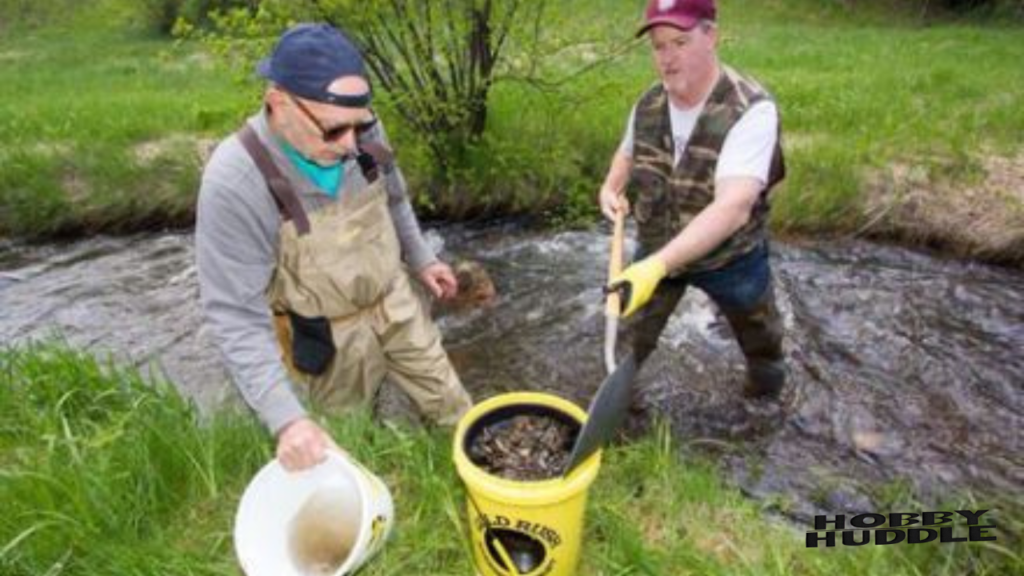
Techniques and Equipment
Successful gold panning requires the right techniques and equipment. While the basic principle remains simple – separating gold from sediment using water and gravity – mastering the art takes practice and patience.
Essential Equipment
Every gold panner needs a few key pieces of equipment. A sturdy gold pan is your most important tool. Look for one with deep riffles to trap gold effectively. A classifier sieve helps sort materials before panning, saving time and energy. Don’t forget essentials like a shovel, bucket, and tweezers for picking up those tiny gold flakes.
| Equipment | Purpose | Approximate Cost |
|---|---|---|
| Gold Pan | Separating gold from sediment | $10 – $30 |
| Classifier Sieve | Sorting material sizes | $15 – $40 |
| Shovel | Digging and moving sediment | $20 – $50 |
| Bucket | Carrying material and water | $5 – $15 |
| Tweezers | Picking up small gold pieces | $5 – $10 |
| Snuffer Bottle | Collecting fine gold | $5 – $15 |
| Magnifying Glass | Inspecting potential finds | $10 – $30 |
| Waterproof Boots | Keeping feet dry | $40 – $100 |
| Gloves | Protecting hands | $10 – $30 |
| First Aid Kit | Safety precaution | $20 – $50 |
Panning Techniques
The basic panning technique involves filling your pan with sediment, submerging it in water, and using a circular motion to separate the lighter materials from the heavier gold. It’s a skill that improves with practice. Many experienced panners develop their own variations on this technique, adapting to the specific conditions of each location.
You Might Like: Dumpster Diving in North Carolina [Is It Legal in 2024?]
Advanced Methods
For those looking to take their gold panning to the next level, consider exploring more advanced methods. Sluice boxes can process larger volumes of material, while metal detectors can help locate larger nuggets. Some enthusiasts even use small suction dredges, though these require additional permits and careful adherence to environmental regulations.
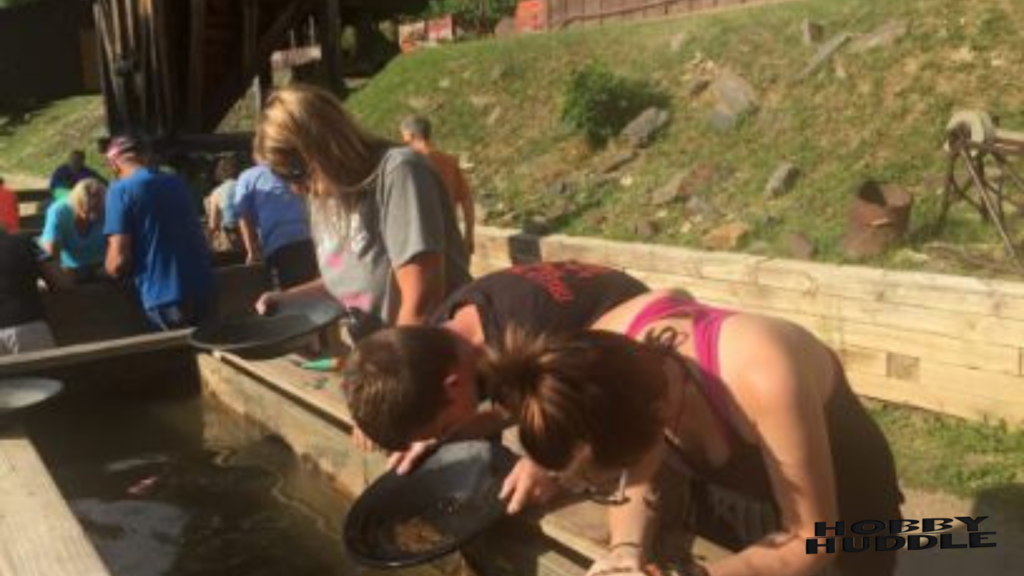
Environmental Considerations
As you embark on your gold panning adventure, it’s crucial to keep environmental concerns at the forefront. Florida’s delicate ecosystems require careful stewardship from all who enjoy its natural resources.
Sustainable Prospecting
Practicing sustainable prospecting means minimizing your impact on the environment. Refill any holes you dig, avoid disturbing vegetation, and pack out all trash. Remember, the goal is to leave the area as pristine as you found it, ensuring future generations can enjoy the same beauty and opportunity.
Wildlife Awareness
Florida’s rivers and streams are home to diverse wildlife. Be aware of your surroundings and respect the habitats you’re working in. Avoid areas with nesting birds or sensitive plant species. Your gold panning adventure should never come at the cost of Florida’s rich biodiversity.
Legal Considerations and Regulations
Before you start panning, it’s essential to understand the legal landscape. Gold panning regulations in Florida can be complex, involving a mix of federal, state, and local laws.
Public Land Access
While some areas are open to recreational panning, others may be off-limits. Always check with local authorities and obtain any necessary permits before panning. Land use regulations can vary significantly from one location to another.
Private Property
If you’re interested in panning on private property, always obtain written permission from the landowner first. Trespassing laws are strictly enforced, and the consequences can be severe.
Environmental Regulations
Florida’s environmental regulations are designed to protect its unique ecosystems. Familiarize yourself with these rules to ensure your panning activities are both legal and environmentally responsible.
| Regulation Type | Description | Governing Body |
|---|---|---|
| Land Access | Determines where panning is allowed | FL Dept. of Environmental Protection |
| Equipment Use | Regulates types of equipment permitted | US Forest Service |
| Water Quality | Protects waterways from pollution | FL Dept. of Environmental Protection |
| Wildlife Protection | Safeguards endangered species | FL Fish and Wildlife Conservation Commission |
| Reclamation | Requires restoration of disturbed areas | FL Dept. of Environmental Protection |
| Mineral Rights | Governs ownership of found gold | FL Dept. of State |
| Permitting | Required for certain activities | Local County Offices |
| Claim Staking | Not applicable in Florida | N/A |
| Dredging | Heavily restricted or prohibited | US Army Corps of Engineers |
| Cultural Resources | Protects historical sites | FL Div. of Historical Resources |
Planning Your Gold Panning Trip
A successful gold panning expedition requires careful planning. Consider factors like weather, accessibility, and the best times of year for panning in your chosen location.
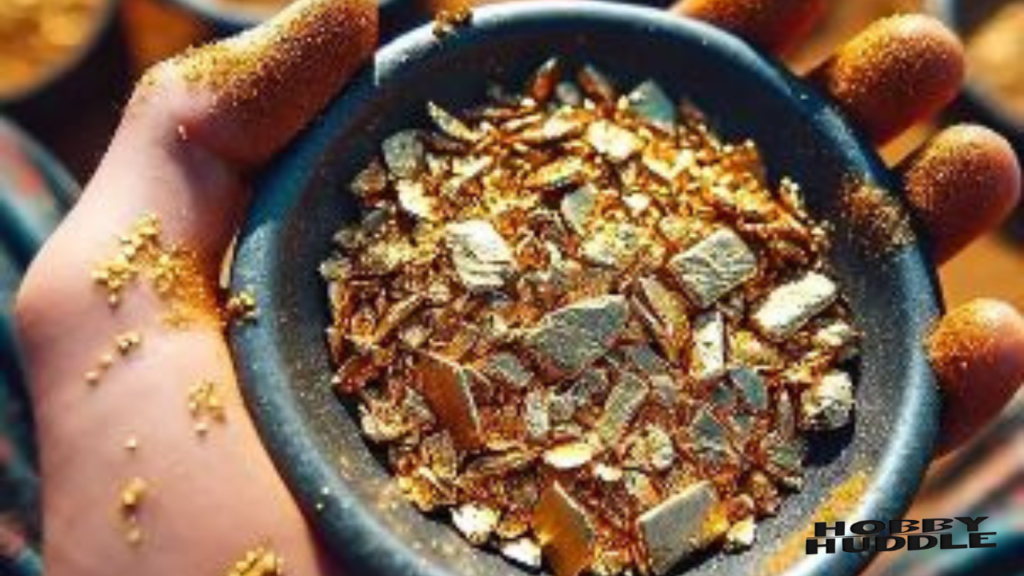
Seasonal Considerations
Florida’s climate can significantly impact your gold panning experience. Summer months offer longer daylight hours but can be intensely hot and humid. Winter provides more comfortable temperatures but shorter days. Spring and fall often offer the best balance, with pleasant weather and moderate water levels in many rivers and streams.
Weather Information
Always check the weather information before heading out. Sudden storms can make rivers dangerous, and prolonged dry spells can lower water levels, affecting your panning spots. Use reliable weather apps or services to stay informed about conditions in your chosen area.
Accessibility and Transportation
Some of the best gold panning locations in Florida are off the beaten path. Ensure you have appropriate transportation to reach your destination. Four-wheel drive vehicles might be necessary for some remote locations. Always inform someone of your plans and expected return time, especially when venturing into less-traveled areas.
Accommodations and Supplies
If you’re planning an extended trip, research accommodation options near your panning locations. Camping can be a great way to immerse yourself in the experience, but be sure to obtain necessary permits and follow all camping regulations.
| Item | Purpose | Quantity Recommended |
|---|---|---|
| Water | Hydration | 2-3 liters per person/day |
| Snacks | Energy | Varied, based on trip length |
| Sunscreen | Sun protection | SPF 30+ |
| Insect Repellent | Bug protection | 1 bottle per 2-3 days |
| First Aid Kit | Emergency care | 1 comprehensive kit |
| Map/GPS | Navigation | 1 per group |
| Extra Clothes | Comfort/safety | 1 set per person |
| Flashlight | Visibility | 1 per person |
| Multi-tool | Utility | 1 per group |
| Trash Bags | Leave No Trace | 2-3 per day |
The Gold Panning Community
Joining the gold panning community can enhance your experience and increase your chances of success. Local clubs and online forums are excellent resources for information extraction about promising locations, techniques, and regulations.
Local Clubs and Associations
Florida has several gold prospecting clubs that welcome newcomers. These organizations often host events, workshops, and group outings. Joining a club can provide valuable networking opportunities and access to shared knowledge and resources.
Online Resources
The internet is a treasure trove of information for gold panning enthusiasts. Forums, social media groups, and dedicated websites offer platforms for sentiment analysis of different locations and techniques. These online communities can be invaluable for staying updated on the latest trends and discoveries in Florida gold panning.
Education and Skill Development
Continuous learning is key to improving your gold panning skills. Many experienced panners are happy to share their knowledge, and there are numerous resources available for those looking to enhance their abilities.
Workshops and Courses
Look for workshops or courses offered by local experts or clubs. These hands-on learning experiences can significantly accelerate your skill development. Topics might include advanced panning techniques, mineral identification, and local geology.
Books and Guides
Invest in some quality books and guides about gold panning in Florida. These resources can provide in-depth information extraction about the state’s gold-bearing regions, historical context, and proven techniques.
Online Tutorials
The internet offers a wealth of video tutorials and articles on gold panning. While these can’t replace hands-on experience, they’re excellent for learning new techniques and staying updated on the latest equipment and methods.
The Science Behind Gold Panning
Understanding the science behind gold panning can greatly improve your success rate. This knowledge helps you make informed decisions about where and how to pan.
Geology Basics
Florida’s gold deposits are primarily the result of ancient geological processes. Understanding concepts like erosion, sedimentation, and mineral deposition can help you identify promising locations. Topic modeling of geological reports and studies can provide valuable insights into Florida’s gold-bearing regions.
Hydrology and Gold Deposition
Rivers and streams play a crucial role in gold deposition. Learning about how water flow affects the distribution of gold can help you pinpoint the most likely spots within a waterway where gold might accumulate.
Mineral Composition
Gold is often found in association with other minerals. Familiarizing yourself with these companion minerals can help you identify potentially gold-bearing areas. Text classification of mineral reports can assist in understanding the typical mineral compositions found in Florida’s gold-bearing regions.
Technology in Gold Panning
While traditional methods remain popular, technology is increasingly playing a role in modern gold panning. Embracing these technological advancements can enhance your gold panning experience and potentially improve your results.
Metal Detectors
Advanced metal detectors can help locate larger gold nuggets that might be missed by traditional panning methods. While not a replacement for panning, they can be a valuable complementary tool.
Drone Surveying
Some prospectors use drones to survey potential panning sites from above. This can help identify promising areas and assess accessibility before venturing out on foot.
Smartphone Apps
Various smartphone apps can assist in your gold panning adventures. From geolocation services to help navigate to specific coordinates, to apps that provide environmental data about water levels and soil composition, technology can be a valuable ally in the field.
The Future of Gold Panning in Florida
As we look towards the future, gold panning in Florida continues to evolve. New discoveries, changing regulations, and advancing technology all play a role in shaping the landscape for prospectors.
Emerging Trends
Keep an eye on emerging trends in the gold panning community. Keyword extraction from industry publications and forums can help you stay ahead of new techniques or equipment that might enhance your panning success.
Environmental Considerations
As awareness of environmental issues grows, expect to see more emphasis on sustainable prospecting practices. Future regulations may further restrict certain activities to protect Florida’s ecosystems, making it crucial to stay informed and adapt your methods accordingly.
Technological Advancements
Advances in technology may soon allow for more precise mineral identification in the field. Portable spectrometers and other high-tech tools could revolutionize how prospectors locate and identify gold deposits.
Conclusion
Gold panning in Florida offers a unique blend of history, outdoor adventure, and the thrill of discovery. Whether you’re a seasoned prospector or a curious beginner, the Sunshine State’s rivers and streams hold the potential for golden surprises. By understanding the geology, mastering the techniques, respecting the environment, and staying informed about regulations, you can embark on a rewarding gold panning journey in Florida.
| Gold Panning Success Factors | Description | Importance Level |
|---|---|---|
| Location Selection | Choosing gold-rich areas | High |
| Proper Technique | Mastering panning methods | High |
| Equipment Quality | Using effective tools | Medium |
| Patience and Persistence | Consistent effort over time | High |
| Environmental Knowledge | Understanding geology and hydrology | Medium |
| Legal Compliance | Following all regulations | High |
| Safety Practices | Prioritizing personal safety | High |
| Community Engagement | Learning from experienced panners | Medium |
| Seasonal Timing | Panning during optimal conditions | Medium |
| Continuous Learning | Staying updated on new methods | Medium |
Remember, the true value of gold panning often lies not in the gold itself, but in the experiences gained, the connections made, and the beauty of Florida’s natural landscapes explored. So grab your pan, head to the nearest stream, and who knows – you might just strike gold in the most unexpected places.
As you embark on your gold panning adventures in Florida, keep this guide handy. With its comprehensive coverage of techniques, locations, regulations, and insider tips, you’ll be well-equipped to make the most of your golden pursuits in the Sunshine State. Happy panning!

Emma Garcia is a seasoned blogger at Hobby Huddle, where her passion for exploring diverse hobbies shines through her engaging posts. With years of experience in writing and a keen eye for detail, Emma brings readers insightful tips and fresh perspectives on everything from crafts to cooking. Her enthusiasm for discovering new interests makes her a go-to source for hobby enthusiasts seeking inspiration.

